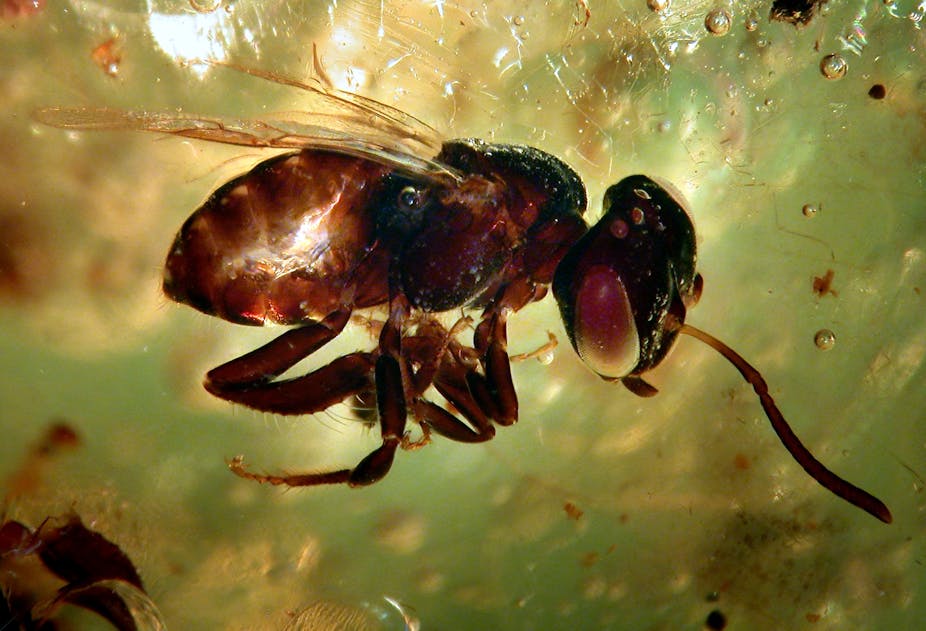On the same day that the latest instalment of the Jurassic Park film series has been confirmed, a study published in the journal PLOS One has detailed experiments that seem to demonstrate once and for all that dinosaurs will never again walk the Earth.
The 1993 film, based on a book by Michael Crichton, depicts a theme park island filled with dinosaurs, resurrected from ancient DNA extracted from fossilised mosquitoes trapped in amber. For a while, that science didn’t seem to be entirely fiction. In the early 1990s, several scientists announced they had extracted DNA from insects fossilised amber as long as 130 million years ago. Insects from this time in Earth’s history, the early Cretaceous period, would have flown among dinosaurs (including giant, long-necked sauropods, among the largest creatures ever on land) as well as creatures such as flying pterosaurs, swimming plesiosaurs, feathered birds, and mammals.
This Lebanese amber was until recently the oldest in the world, older than the more common Dominican amber, which formed around 16 million years ago, and the 49-million-year-old amber of the Baltic. But last year, tiny mites were found for the first time in amber dating from the Triassic period – 230 million years ago.
While the premise of the film – that dinosaur DNA could be extracted from the guts of a preserved mosquito that had recently dined on one – seems reasonable, the fragile nature of DNA and the huge expanse of time that has passed has led many experts to doubt claims to have extracted any DNA that old—including DNA from the insect itself.
David Penney, a palaeontologist and expert in amber-preserved spiders and insects at the University of Manchester, carried out experiments to try and confirm once and for all whether DNA could be extracted from creatures fossilised in amber. With Terry Brown, an ancient DNA expert also at the University of Manchester, they used the latest “next generation” DNA extraction and sampling techniques to avoid DNA contamination.
“We used Manchester’s specialised, dedicated laboratories that are only used for analysing ancient DNA”, Penney said. “Any DNA traces will be be tiny pieces of ancient, fragmented material, so it’s important to avoid contamination with modern DNA.” The laboratories are sterilised, the air filtered, and scientists wear full-body decontamination suits.
The specimens from which scientists claimed to have successfully extracted DNA were of stingless bees, and Penney used examples of the same species. One was about 10,600 years old, the second was preserved just after World War II – only about 60 years ago. Both samples were extracted from copal, a hardened form of tree sap that had encased the insects; it’s an intermediate stage that had not fully fossilised into amber. Chemicals were used to dissolve away the copal before samples were taken from the creature held inside.
The results were pretty conclusive: “In the oldest specimen we found no viable DNA,” Penney said. “In the newer sample, we found various bacterial and other DNA, but nothing that was certifiably from the bee.”
Brown explained that an older technique known as PCR was used in the 1990s experiments, and it may have caused problems: “The process, called polymerase chain reaction, will preferentially amplify any modern, undamaged DNA molecules that contaminate an extract of partially degraded ancient ones and give false positive results that might be mistaken for genuine ancient DNA.”
The process of fossilisation, whether in rock or amber, chemically changes the makeup of the organism it preserves. Over time, with heat and pressure, the remains are transformed, and they no longer contain the organic material that might harbour DNA.
If viable DNA cannot be extracted from a bee that is only as old as someone living today, there is no chance that it could be obtained from specimens hundreds of millions of years old. But that doesn’t mean the amber samples are useless.
“The preservation of these creatures in amber is remarkable, and they give us an insight into the past, and can shed light on the possible future of the tropical forests of today,” Penney said.“I suppose it’s a bit of a shame that we can’t extract DNA from these creatures – I was even expecting to find some in the younger specimen – but it seems Jurassic Park must remain in the realms of fiction.”

